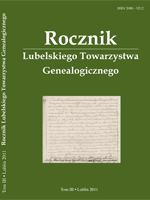O nazwisku w jasnogórskim zabytku polskim z początku XVIII w.
Of Surname in Polish Relic from Jasna Góra Dating from the Beginning of the 18th Century
Author(s): Aneta MajkowskaSubject(s): Language and Literature Studies
Published by: Lubelskie Towarzystwo Genealogiczne
Keywords: The Archives of Jasna Góra; epistemology; surname forms; primeval attributes of nickname
Summary/Abstract: The Archives of Jasna Góra contain a microfilm of a relic Polish Queen in Iasnogora. Service for every day in the year in veneration of Virgin Mary, made in 1986. The content matter of the relic, apart from its epistemological significance (it is an indicator informing about the world of thought and ideas pertaining to the social milieu of the Baroque period), is also evidence of the trends in the formation of surnames at the beginning of the 18th century. The following groups of surname forms appear in the relic Polish Queen in Iasnogora: 1) primeval attributes of nickname and nominal type constitute 18,45%, e.g. Jarzyna, Pukiel; 2) secondary surname formations make 81,55% of the analysed data. They include patronymic and possessive formations, called gentry type. Patronymic formations constitute 17,47%, among them those ending in –i/yc, –i/ycz (2,91%), e.g. Dudzic, Woydycz; ending in –owicz, –ewicz (6,80%), e.g. Joachimowicz, Kłębowicz, Dudkiewicz; ending in –ek, -ak, -uk (7,76%), e.g. Lisek, Dziubek, Trepka, Baniuk. “Gentry” surnames constitute as much as 64,08%, among them those ending in –ski, -cki (30,09%), e.g. Kaliska, Obliska, Porębska, Zamoyska; Lubieniecka, Siedlecka, Woycicka; ending in –i/yński, -e/ański (11,65%), e.g. Brzezińska, Działyńska, Kłodzińska; ending in –owski, -ewski (16,50%), e.g. Brzozowska, Karbowska, Myszkowska, Wilkanowska, Strzyżewska.
Journal: Rocznik Lubelskiego Towarzystwa Genealogicznego
- Issue Year: 2011
- Issue No: 3
- Page Range: 49-59
- Page Count: 11
- Language: Polish

